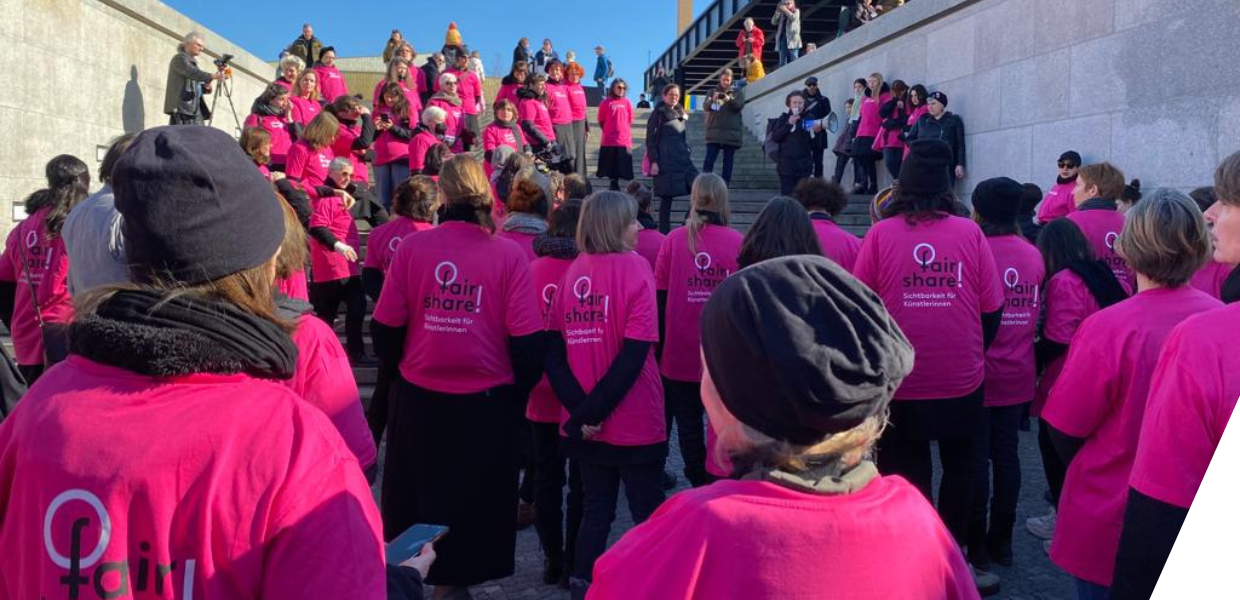Underrepresentation of women artists
Although the topic of gender equality is currently much discussed, the number of permanent works of art by women in museums remains low across the globe. In the art departments of German institutions (taking the example of where the fair share! alliance is based), there is hardly any art created by women before the 1970s. A museum such as the Alte Nationalgalerie in Berlin, which research shows, has about 1.5% women artists in its collection, is representative of comparable collections.
There is also an acute need to catch up in the contemporary field. According to our own research, at the Hamburger Kunsthalle, only 19% of the contemporary artworks are by women, and only 14% of the works on show in the Collection of Modern Art at the Pinakothek der Moderne, Munich are by women. To give another example, research in 2017 showed that only 11% of the artists at the Museum Ludwig were women; since 1989 solo exhibitions by women artists have accounted for only 20%. This is despite the fact that the majority of art school graduates in Germany have been female for years (59% in 2018/19).
As the fair share! alliance, we advocate for more visibility of female artists in the art scene. We demand a quota in all areas of contemporary art as well as a revaluation of historical positions of female artistic creation.
Raising awareness of the issue
The alliance was founded by Ines Doleschal and Rachel Kohn in 2020. We organise events and performances to draw attention to the issue of lack of representation of female artists and advocate for change.
For example, the modernist collections of the National Museums in Berlin are presented in the basement of the famous building by Mies van der Rohe. Our research shows that there are currently 22 women artists out of 110 artists on show, and of the 250 works on display, 14% were created by women artists. According to the director, only 9% of the artworks in the collection of the Neue Nationalgalerie are by women artists. These include Hannah Höch, Natalja Goncharova, Lotte Laserstein, Lou Loeber, Marg Moll and a further 17 artists of Expressionism, Surrealism, Constructivism and Dadaism. In the run-up to the opening of the building, the fair share! alliance called for a greater presence of women artists in the permanent collection through a spontaneous nocturnal art action where we pinned 800 names of women artists to the building’s fence.
Every International Women’s Day, the Berlin action fair share! alliance also prepares a performance. In 2022, addressing the imbalance described above, it focused on forgotten female artists that should be included in the collection of the Neue Nationalgalerie Berlin. We suggested ‘A woman in every window’, where 110 female artists and cultural workers walked around the museum to represent female artists of the classical modern era. On their shirts they wore the name of a woman artist of classical modernism who could be represented in the show collection - if her works had been collected.
For the day of the performance, each participant became an expert on ‘her’ artist. After the performance, visitors could contact the participants and ask them about their lives and work. This created a pool of information that makes many undiscovered, long-forgotten and strongly underrepresented women artists visible.
In 2023, fair share! activists gathered directly in the centre of political decision-making near the Bundestag. This year they demanded fair payment for their work, greater visibility and the recognition of women’s potential in the visual arts. fair share! activists dressed in pink letters with a variety of slogans, while at a ‘Feminist Corner’ other activists articulated demands in various formats. A special highlight were activists on a boat passing by and shouting slogans such as ‘fair pay for women artists’.
Changing approaches for the future
As we aim to raise awareness of this issue and encourage change, there are a number of steps that cultural heritage institutions around the world can take to increase the representation of women in their collections, including:
Acknowledge the past and present achievements of women artists through
a reassessment of your archives, art repositories and acquisitions
Incorporate a gender-sensitive design of acquisitions and exhibitions
Buy art from woman artists: increase their works in your collections and exhibitions - aim for 50% in contemporary art
Conduct or join research projects and promote publications on women artists
Contribute to the revision and supplementation of art-history publications and textbooks in education
Advocate for more targeted subsidies and prizes for women artists of all ages
Lift age restrictions for calls of proposals
Support programmes for artists with child-rearing and care responsibilities, and develop targeted support schemes for re-entry after family leave
Promote specific funding and grants for women artists with care responsibilities
Use arts research networks to participate in debates, share knowledge and resources
In Germany specifically, support the creation of a project to create a nationwide database of women artists and monitoring office, to analyse the representation of women artists in German museums and collections, based in the Federal Ministry for Culture and Media
For more about our actions visit our website. You can also explore Women’s History on Europeana.eu.



